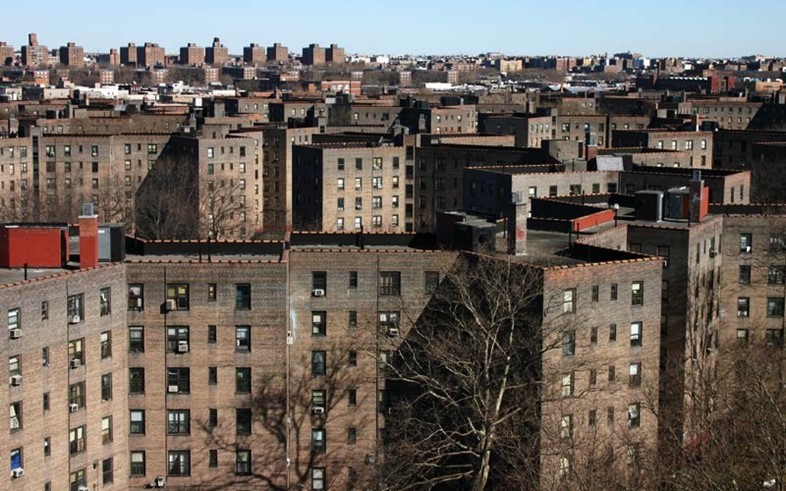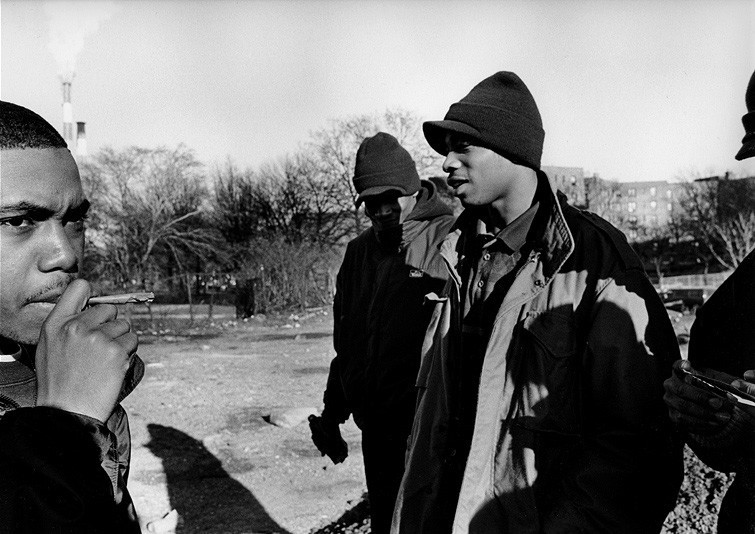On the 20th anniversary of Illmatic we bounce back to Queensbridge, the home that ignited the spark for his groundbreaking album
It's been 20 years since Nas released his debut album, Illmatic, which set a new gold standard for hip-hop lyricism and drew a hyper-vivid portrait of his home Queensbridge, the biggest housing projects in New York. As MC Shan puts it, the Bridge is where "stars are born" – but it didn't just spawn Nas and musicians like Mobb Deep and Marley Marl, it also provided the inspiration for their sound. This feature from the August 2006 issue of Dazed & Confused goes deep into QB and its fraught relationship with its most famous sons.
In 1939, the Queensbridge housing projects opened. Situated just south of the Queensboro Bridge that links Manhattan to Queens, it was – and still is – the largest public housing project in the United States, playing host to a multi-racial community of families all looking to take advantage of the development’s cheap living. During the 1950s, the racial and socio-economic balance of Queensbridge shifted irreversibly when the city made the decision to move out any families with an income of more than $3,000 a month. Unsurprisingly, the majority of these families were white.
By the 1980s, the area had turned into an urban hellhole, with murder and rape commonplace, and crack use increasing. Like the Bronx, it was a no-go area. At the beginning of the 1990s, a group of Queensbridge rappers, most notably Nas and Mobb Deep, used this harsh backdrop as noir artistic inspiration, dropping classic albums like Illmatic and The Infamous before making their money and moving on.
Today, the residents are left gazing at stars who’ve left through the gates of a community lacking the most basic everyday amenities – a bank, somewhere for kids to play, somewhere to get a cup of good coffee. Still, there is the murmur of a beating heart trying to turn things back to the good days.
Walking through the heart of Queensbridge on a summer weekend, with the North Houses of 40th Avenue on one side and the South Houses of 41st Avenue on the other, you’re struck that, beyond the idea that the identikit brown six-story brick buildings that make up the project must be filled with piss-strewn stairwells brimming with nefarious activity, you could be in any close-knit neighbourhood – a couple walk by clutching a cluster of purple balloons, a group of old folk talk outside in the sun, and kids run to the subway stop to play on the escalator. The station is a constant reminder to the place’s sheer size – Queensbridge is the only housing development in New York to have a subway stop named after it.

“This is why I wanted you to walk through Queensbridge on your own,” smiles Selena Blake, a documentary maker and my impromptu tour guide, once I reached the other side of the projects. “I wanted you to experience walking through Queensbridge and feel that despite what you may have heard, nobody is going to harm you.”
As she weaves through the buildings, pointing out where famous former faces used to live, she’s soon joined by a couple of aspiring resident rappers, Cutta and A Fontaine. The three talk colourfully about Queensbridge’s rich folklore, telling stories about monsters swimming with the fishes in the nearby East River, pointing out Exile, an old after-hours haunt of Frank Sinatra, speculating on a group of truly underground tenants rumoured to live in a disused tunnel connecting Queens to Roosevelt Island, and laughing about a local homeless character called Pipeyard Joe who used to scare the kids. There’s a palpable sense of pride in their voices as they talk up their area – that is until they reach a small line of vacant stores.
“Look around!” exclaims Selena with an angered sadness to her voice. “This is the core and what the hell is this? This is all we have.” She’s talking about “The Hill”, the social centre of Queensbridge, common meeting point and, it seems, an area that economic development has passed by. A sign above a barbershop, one of the few businesses that is open, shows a painting of an Italian man, harking back to the area’s original mixed demographic.
“You wanna take your little man for an ice-cream cone but you can’t as this is all there is,” she continues. “As a culture, we hate change, but if it means that a grocery store like Pals is going to be replaced with something better, then I’m all for that. Put in a bakery where we can go and get a cup of espresso and a piece of cake. I’ve seen what the current situation has produced – a bunch of young men who haven’t got anything.”
With an estimated 15,000 residents – an entirely captive market – it flies in the face of financial logic for Queensbridge not to have bustling local traders. Similarly, the lack of a bank – meaning that residents have to travel into Manhattan – is currently on the campaign agenda. However, despite a New York City politician pledging to invest $100,000 of his own money should a bank be established in Queensbridge, the prospect of it happening anytime soon elicits little more than a shrug of disbelief from Cutta.
A short walk from The Hill lies the Jacob Riis Community Center, a former focal point for artistic and sporting pastimes that now prompts more scorn of the city’s management of Queensbridge.
“On Saturday mornings, we used to get up early and play basketball, but now it’s locked up to the kids,” explains Fontaine. Passing the building in which Nas used to live sparks further comment.
“Nas can go and spend three or four million on a house in Miami for him and his wife, but the kids here now don’t even have anywhere they can perform their music!” says Selena.

When asked if, in their opinion, any rappers who’ve moved on from Queensbridge yet still shout out the area on record, have put anything back into the community in a tangible manner – setting up music centres or donating instruments, for example – Cutta and Selena engage in a heated exchange.
“Well Littles [a Mobb Deep affiliate] is an indie rapper who gives to the community,” Cutta says. “He gives out turkeys on Thanksgiving.”
“I’m not talking about turkey,” Selena instantly retorts. “We can buy our own damn turkeys!”
“That’s still giving, Selena,” Cutta counters, “That’s better than what other rappers are doing.”
“What I’m talking about is helping out,” Selena states. “We can feed ourselves. We want people who are from Queensbridge to always support Queensbridge and not just bring a turkey. Don’t get me wrong, I have nothing against turkey, but feed my mind not my stomach. My mind’s gonna have that knowledge forever but I’m going to be hungry in a bit. The minds here need nourishing, not the stomach. My only challenge to the people who’ve moved on is to start programmes and attach yourself to an organisation.”
While it’s easy to understand the frustration towards those who’ve moved on, Wiz, a rapper who is part of the group Bravehearts that Nas once signed to Columbia Records, offers a more assertive view of giving back to the community.
“Nas gave the people here some salvation and hope,” he begins, sitting at a stone table on which a chess board is marked out. “He came back, picked people up and gave them jobs, took them on tour, took them around the world, gave them opportunities. It wasn’t just little kids looking up to Nas, he was giving people that opportunity to do something with their lives that they always talk about.”
In the small playground further over from where Wiz is lounging, there is a scene that is saddening yet strangely hopeful: a couple of grown kids stand around with those rolls of dollar bills that street sense suggests mean drug dealing, while just over from them stands a solitary rocking toy.
“This is the oldest toy in the playground right there,” says Fontaine. “That’s the only one left.” Further over, a group of young children are playing.
“We want to plant seeds for the future,” sums up Selena. “We want to show them that the sense of community can win out.”




